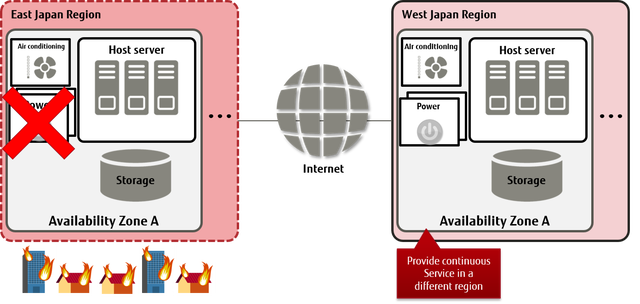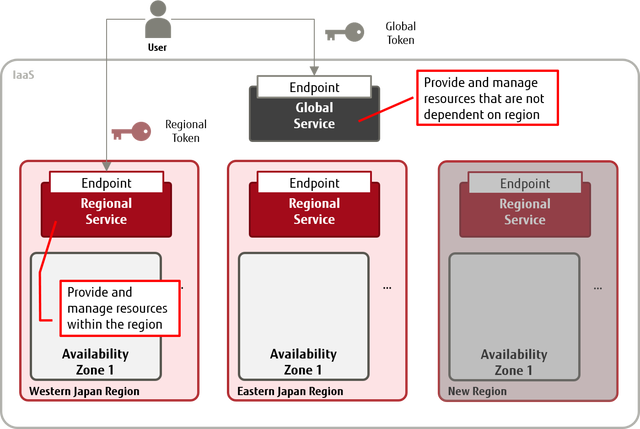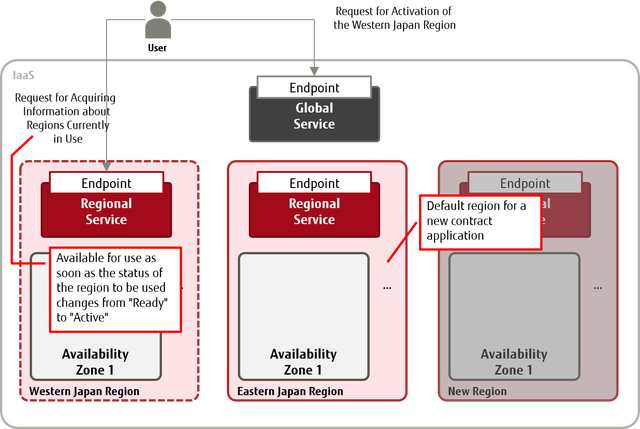Region
This function provides an environment where multiple regions can be used with a single IaaS account. Such an environment can be used to develop large-scale services or as a measure against disaster.
Regions are geographical areas of Japan or other countries that are separated, such as would be created by splitting along a north-south or east-west divide. Regions are connected via the Internet to form a Wide Area Network.
Figure: Example of Using Multiple Regions

Available Regions
The following regions are provided.| Country | Name of Region | Abbreviation | Region Identifier |
|---|---|---|---|
| Japan | Eastern Japan Region 1 | Japan East1 | jp-east-1 |
| Eastern Japan Region 2 | Japan East2 | jp-east-2 | |
| Western Japan Region 1 | Japan West1 | jp-west-1 | |
| Western Japan Region 2 | Japan West2 | jp-west-2 |
IaaS Service Configurations
-
Global Services
Global services have a single API endpoint as IaaS, and provide resources and services that are not dependent on region. They are used by acquiring global tokens.
-
Regional Services
Regional services have a single API endpoint for each region, and provide resources and services within the region. They are used by acquiring regional tokens.
For details, refer to the following manuals:
- Explanations of services in IaaS Service Specification
- IaaS API Reference Manual
Figure: Concept of Global Services and Regional Services

Functions Included
-
Region Activation Function
This function is used to add a new region to the regions that are currently being used.
Tip: When a contract number (domain) is acquired, "Eastern Japan Region 2 (jp-east-2)" can be used as the default region.Figure: How to Use a Different Region

-
Function for Acquiring Information about Regions Currently in Use
You can acquire a list of regions that are currently in use, as well as their availability ("active" or "ready").
-
Authentication Functions
-
Global Authentication Function
The global token acquisition function is provided to allow the use of global services.
Tip: Use the global user management service to acquire tokens. -
Regional Authentication Function
The regional token acquisition function is provided to allow the use of regional services.
Tip: Use the regional user management service to acquire tokens.
-
-
API Endpoint
For the API endpoints accessed in order to use the services, refer to Endpoint.
How to Use This Service
Figure: How to Start Using Multiple Regions

Points to Note
-
Common
- Once you have started using a region, you cannot stop using that region.
-
Global tokens and regional tokens that are acquired with the authentication function cannot be used interchangeably. Use tokens correctly according to the services and resources that you want to use.
- Use of regional services with global tokens
- Use of global services with regional tokens
-
Global Services
-
Global User Management Service
-
If you use the global user management service to create or change resources, there will be a time lag until all regions are synchronized.
Tip: You can use the "Check Synchronization between Regions" function provided by the global user management service to check if synchronization is complete in the region you want to use.
-
-
DNS Service
Important:The following operations are required to use a DNS service.
- Create a project in "Eastern Japan Region 1 (jp-east-1)," and register in that project the user who will use the DNS service.
- Use a regional token.
-
-
Regional Services
-
Email Delivery Service
Note: Only "Eastern Japan Region 1 (jp-east-1)" is provided.
-